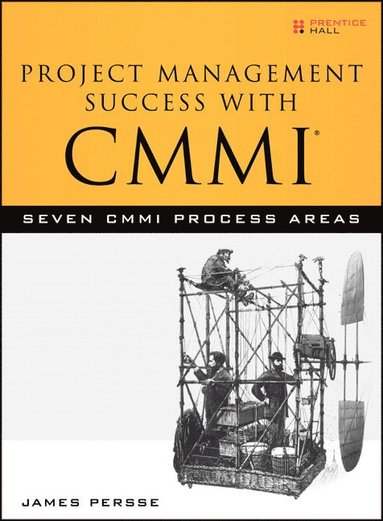
- Format
- Häftad (Paperback)
- Språk
- Engelska
- Antal sidor
- 321
- Utgivningsdatum
- 2007-07-01
- Upplaga
- 1
- Förlag
- PRENTICE-HALL
- Illustratör/Fotograf
- Illustrations
- Illustrationer
- Illustrations
- Dimensioner
- 236 x 186 x 27 mm
- Vikt
- Antal komponenter
- 1
- Komponenter
- ,
- ISBN
- 9780132333054
- 854 g
Project Management Success with CMMI: 7 CMMI Process Areas
Seven CMMI Process Areas
Slutsåld
Kundrecensioner
Fler böcker av James Persse
-
Process Improvement Essentials
James R Persse, James Persse
Today, technology has become too much a part of overall corporate success for its effectiveness to be left to chance. The stakes are too high. Fortunately, the idea of 'quality management' is being reinvigorated. In the last decade process program...
-
ITIL Process Manual
James Persse, Van Haren Publishing, Van Haren Publishing
Övrig information
James Persse has 18 years of experience providing process improvement design and consulting services to both large and small technology organizations. His specialties include CMMI, ISO 9001:2000, Six Sigma, and ITIL. He holds a doctoral degree in Information Technology Management with an emphasis in process improvement. He has worked with a diverse client base that includes T-Mobile USA, Athena Technologies, the U.S. Department of Defense, Celerity Technical Services, Pitney Bowes International, MCI, BellSouth Science and Technologies, and Palmetto GBA. James is the author of Process Improvement Essentials: CMMI, ISO 9001, Six Sigma (O'Reilly Media, 2006); Implementing the Capability Maturity Model (John Wiley and Sons, 2001); and Bit x Bit: Topics in Technology Management (Little Hill, 2000). He can be reached at jpersse@AltairSol.com or jrp@persse.com.
Innehållsförteckning
Preface xvAcknowledgments xixAbout the Author xxiChapter 1: Introduction 1
Project Management as Value Management 4
Visible Management through Process 7
Chapter 2: Project Management Success through Process 13The Capability Maturity ModelA Process Improvement Framework 14
CMMI-DEV for Process Improvement 17
CMMI-DEV Process Areas 23
Institutionalizing Process Areas with Generic Goals 38
Two Ways to Implement CMMI 41
CMMI and Project Management 49
Chapter 3: Project Planning 57The Purpose of Project Planning 58
What Is a Plan? 61
Project Planning Goals and Practices 62
SG 1: Establish Estimates 63
SG 2: Develop a Project Plan 71
SG 3: Obtain Commitment to the Plan 85
The Benefits of Controlled Project Planning 92
Some Example Program Components 94
Look to the Web Site for 95
Chapter 4: Project Monitoring & Control 97The Purpose of Project Monitoring & Control 98
The Heart of the Project 101
Project Monitoring & Control Goals and Practices 102
SG 1: Monitor Project Against Plan 103
SG 2: Manage Corrective Action to Closure 116
The Benefits of Project Monitoring & Control 121
Some Example Program Components 124
Look to the Web Site for 125
Chapter 5: Requirements Management 127The Purpose of Requirements Management 128
Requirements Management Goals and Practices 134
SG 1: Manage Requirements 135
Some Other Ways to Achieve the Practices 152
The Benefits of Sound Requirements Management 153
Some Example Program Components 155
Look to the Web Site for 158
Chapter 6 : Configuration Management 159The Purpose of Configuration Management 160
Configuration Management Goals and Practices 166
SG 1: Establish Baselines 167
SG 2: Track and Control Changes 177
SG 3: Establish Integrity 182
The Benefits of Sound Configuration Management 186
Some Example Program Components 188
Look to the Web Site for 192
Chapter 7: Supplier Agreement Management 193The Purpose of Supplier Agreement Management 194
Supplier Agreement Management Goals and Practices 198
SG 1: Establish Supplier Agreements 199
SG 2: Satisfy Supplier Agreements 207
The Benefits of Supplier Agreement Management 217
Some Example Program Components 219
Look to the Web Site for 221
Chapter 8: Measurement & Analysis 223The Purpose of Measurement & Analysis 224
Measurement & Analysis Goals and Practices 228
SG 1: Align Measurement & Analysis Activities 229
SG 2: Provide Measurement Results 237
The Benefits of Measurement & Analysis 239
Some Example Program Components 242
Look to the Web Site for 245
Chapter 9: Process & Product Quality Assurance 247The Purpose of Process & Product Quality Assurance 248
Process & Pr...
Du kanske gillar
-
Peak Human
Johan Norberg
Häftad -
Hayek's Bastards
Quinn Slobodian
Inbunden -
Atomic Habits
James Clear
Trade paperback (UK) -
Chip War
Chris Miller
Häftad
